Cardyn Brooks's Blog, page 23
January 19, 2019
Hot Love in the Kitchen & Travelling Through Time
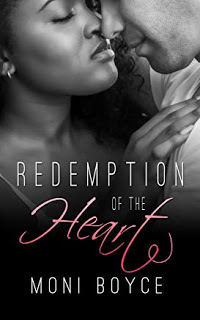
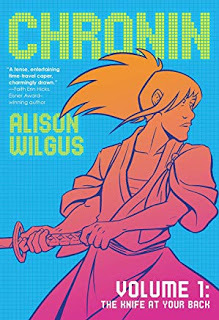
Redemption of the Heart by Moni Boyce
contemporary romance
Love Snacks Publishing 8 January 2019
Despite addressing heavy themes of domestic violence, incarceration, and grief, Redemption of the Heart is a charming and sweet spicy read in the tradition of a 21st-century interracial homage to Janet Dailey’s monthly romance era. Gemma’s open-hearted ingénue contrasts starkly with Alex’s jaded workaholic. They struggle with a variety of challenges, but ethnicity isn’t one of them—a spin that feels particularly modern. Once readers commit to their suspension of disbelief regarding the cascading impact of lacks in due diligence by several characters, it’s easy to settle in to enjoy this love story.
The recent public debate about the pros and cons of Gillette’s “We believe the best man can be” campaign ties in with the contradictory messages in the story threads about toxic masculinity. There’s a scene in which Alex apologizes to someone who was openly bragging among coworkers about how he planned to get Gemma in bed, but this minor character never apologizes (nor is expected to do so) to Gemma and Alex for his unprofessional, disrespectful behavior, which seems to get excused as “wisecracks” and other misleadingly innocuous labels. At the same time, Alex’s willingness to acknowledge when he’s actually wrong and to apologize are two of the most appealing traits he possesses. In one way this friction portrays the testosterone-dominant restaurant industry, but the wrong person’s behavior is being questioned.
Forgiveness, second chances, adult offspring recognizing their parents as complicated individuals, and the benefits of therapy are only a few of the many reasons to read this optimistic love story. Yes, there are patterns of minor proofing oversights. The strength of the characterizations, storytelling momentum, and incendiary sensuality more than outweigh them.
lovesnackspublishing.com
Chronin Volume 1: The Knife at Your Back by Alison Wilgus
comics & graphic novels
Tor Books 19 February 2019
This amalgam containing elements of Victor Victoria and the recently cancelled “Timeless” television show offers a visual rendering reminiscent of Modern Japan: A Very Short Introduction by Christopher Goto-Jones. The sharp edges and soft shadings in gray scale appeal to the eye and support the spare dialogue, which punctuates the action in panels with the look of gorgeous woodcuts.
Yoshida and Hatsu’s journey in 1864 Japan resonates with present-day conflicts between social classes, Eastern and Western nations, and limiting expectations based on gender.
Volume 1 ends on a juicy cliffhanger.
alisonwilgus.com
Published on January 19, 2019 12:01
December 9, 2018
Fly Like a Girl, Move Among the Stars & Ponder the Universe
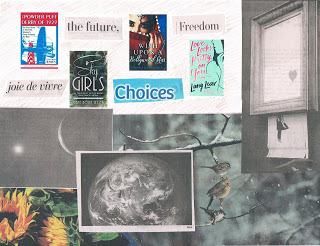
#CardynBrooksReviews #books
Sky Girls by Gene Nora Jessen with Foreword by Eileen Collins Aviation non-fiction history Originally published March 1, 2002; Sourcebooks reprint edition August 18, 2018
Opening with a foreword from retired U.S. Air Force Colonel Eileen Collins who was a NASA astronaut and also the first female commander of a space shuttle, this 2018 reissue of 2002’s The Powder Puff Derby of 1929 starts with a brief overview of aviation from ballooning in the 1700s. Transitions between centuries, generations, and innovations jump a bit from point to point in the introduction, but smooth out in the main text where the daily log format including thumbnail biographical sketches of this cast of intriguing real-life characters establishes the narrative structure of an exciting and dangerous adventure being retold by the survivors to their heirs.
Gene Nora Jessen’s immense knowledge of aviation mechanics and lore combined with her direct access to a few of the actual participants in the first women’s cross-country air race steeps Sky Girlsin the personally intimate tone of a family saga being passed down from one generation to the next with each younger group adding their own contributions to the historical record. Each day’s summary begins with a map plotting each segment of the race. Black and white photos and images of related documents deepen the feeling of the participants as unique individuals who were risking their lives in order to pursue their shared passion.
“… Racing opens my door to the world. Don’t cut me off from the adventure men have been hoarding for themselves in the guise of protecting me from danger.” For this nameless spokeswoman and for the others, an airplane was obviously the badge of emancipation. [pp. 70 – 71]
In telling the story of women in aviation Sky Girls tells the overall story of aviation. Industry icons Beech, Cessna, Lockheed and others along with enthusiastic advocates such as Will Rogers (who respectfully coined the phrase of Powder Puff Derby) and Howard Hughes are integral elements of this true tale of daring-do. Ninety-Niners, Whirly Girls, and Ida Van Smith are only some of the organizations and people who worked to expand access to aviation instruction and employment opportunities to women. “Finally, in 1973, Chief Pilot Johnny Myers… couldn’t think of any reason not to hire Howell Warner since she was so overqualified compared to the male pilots they were already hiring.” [pg. 324]
As for expanding the general public’s understanding of the science and art of flight and aviators, the epilogue, afterword, author’s note, acknowledgements, photo credits, index, reading group guide, and conversation with the author all contribute to a deeper comprehension of aviation as a professional discipline and as a personal mission.
Wish Upon a Bollywood Star by Pamela Q. Fernandes Inkspell Publishing 10 December 2018 contemporary romance
During what some in entertainment media are calling the Bollywood wedding season with the marriages of Ranveer Singh and Deepika Padukone, Priyanka Chopra and Nick Jonas, and upcoming nuptials for Kapil Sharma and Ginni Chatrath, the dramatic, mostly self-inflicted turmoil in Wish Upon a Bollywood Star is a timely tale. Soumya Ninan, a twenty-six-year-old Keralite woman, meets thirty-six-year-old Punjabi man Vir Seth at the public relations firm where she works as a junior agent-slash glorified gofer. Their best friends Kirti and Dhruva add to the melodramatic rendering of this Cinderella tale set in the 21st century.
Soumya’s impulsive short-sighted actions make her seem more like a spoiled brat than a college-educated professional who has earned a graduate degree. Overheard misogynistic remarks (sadly and recently echoed with the addition of racist overtones in real life about Priyanka Chopra) made by Vir regarding the “Shaadi Trap” lead Soumya to set a chain of events into motion that accelerates to steamroller pace. A fake relationship, misunderstandings, jealousy, and an attempted sexual assault by an envious associate are just a few of the familiar romance tropes included in this contemporary love story with retro attitudes from Barbara Cartland’s heyday used to examine the double standard of sexual virtue for women versus men in modern Indian society and most of the world, to varying degrees.
Initially, readers are asked to take a hug leap of faith in their suspension of disbelief with the premise that Soumya as a public relations professional is clueless about the potential for a variety of negative outcomes directly related to her prank. In her thoughts on pages 17 to 18, “She knew he was right. She hadn’t thought of the consequences when she had made that stupid move… Yes, that must be it: at twenty-six years of age, she was past the age of infatuation,” it’s clear that Soumya is deluding herself about her motives.
Wish Upon a Bollywood Star works as a satirical critique very loosely in the tone of Oscar Wilde’s The Importance of Being Earnest of the impact of caste and class on present-day romantic relationships as academic and professional opportunities expand for women in India. Underlying themes about the heavy personal costs of fame and celebrity play out in a tangential storyline about Vir’s relationship with his co-star. Beyond geographical locations and cultural context, Pamela Q. Fernandes avoids a majority of the most popular distinctly Bollywood interpretations of romance tropes in favor of the more basic sources of conflict like age, economic, and career status disparities. Although challenging and updating Bollywood stories seems to be one of the author’s intentions, including a spontaneous group singing and dancing scene in this short beach read would have been totally incongruous and lots of fun, just like in the movies.
The author’s other works are listed on her site: pamelaqfernandes.com.
These two articles about Bollywood tropes were interesting: www.vagabomb.com/The-Damsel-in-Distre...
www.buzzfeed.com/pulkitd/19-bollywood...
Love Looks Pretty on You by Lang Leav Andrews McMeel Publishing January 29, 2019 poetry
The novelist struggles. The poet suffers. [pg. 105]
Love Looks Pretty on You tilts back and forth between themes of self-reflection and confessions and declarations with the above poem as the fulcrum of this beautifully balanced collection of notes to the author’s younger selves. “Too Young” on page 61 was written when Lang Leav was twelve years old, but the majority of the text ruminates on the whirlwind of experiences during young adulthood.
The introduction proclaims Love Looks Pretty on You as a celebration of the female spirit, which is more directly linked to the authorship of self on page 5 with, “All this time, I thought I was writing for the lovers, when I’ve been writing for the writers.” This seemingly unexpected realization connects the recurring themes of voice, personal back story, past loves, loss, and flowers with the feminine power of creation, regeneration, and resurgence. Ideas about actual and imagined selves or identities wrestle in the past, present, and future.
Lang Leav taps into a generational spectrum of the musical zeitgeist and transposes it into present-day chords with deep emotional reverberations that also incorporate religious and secular imagery. Love Looks Pretty on You, title and overarching themes about romantic relationships, harkens back to the wistful regrets in “You Look So Good in Love” by George Strait. “At Last” on page 6 evokes the yearning ache of the Etta James version of the tune by Harry Warren and Mack Gordon. “The Long Way” echoes the sense of bewilderment in 1979’s “Take the Long Way Home” by Supertramp. There’s a little of Beyoncé’s “Lemonade” on page 77, and essential truths shared with “You Say” by Lauren Daigle, Hailee Steinfeld’s “Most Girls” and Roxette’s “It Must Have Been Love” scattered throughout these intimate reveries.
Some pieces are titled and some are not. All of them capture a facet of being young and searching for one’s strongest, most authentic self.
Now that you have it all, do you ever wish you could go back to when you had it simple? [pg. 95]
Lang Leav throws down the gauntlet above and with “This Year: on page 19. It’s a challenge worth accepting.
The index is arranged alphabetically by title or by the first word for untitled pieces.
Published on December 09, 2018 11:26
November 18, 2018
Snapshots of Lives Real and Imagined
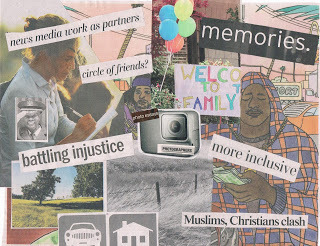
A Stranger's Pose
by Emmanuel Iduma and Abraham Oghobase, et al. with foreword by Teju Cole
Cassava Republic Press
creative non-fiction memoir with photographs
Scheduled for release this week, here's last week's MediaDiversified.org review:
https://mediadiversified.org/2018/11/11/a-strangers-pose-by-emmanuel-iduma-cardyn-brooks-reviews/
Black Girls Must Die Exhausted
by Jayne Allen
Quality Black Books September 2018 contemporary adult fiction with chick lit leanings
There is a substantive distinction between BLACK fiction and fiction written about characters who happen to be black, among other traits, that’s difficult to quantify. Black Girls Must Die Exhausted, the first entry in a scheduled trilogy, falls into the latter category. It is integrated in ways that mainstream contemporary fiction rarely is beyond ethnicity, including socioeconomic class, geographic region, age, and gender.
Blend a 21st-century New Adult version of Waiting to Exhale and “Girlfriends” with candid revelations about traumatic injuries of the spirit reminiscent of For Colored Girls Who Have Considered Suicide/When the Rainbow is Enuf. Toss in the caustic wisdom of seasoned women a la “Golden Girls” or “Grace and Frankie” into a sometimes exclamatory narrative style familiar to fans of Sophie Kinsella to create this endearing tale that’s provocative, funny, and emotionally satisfying.
Of its many thematic layers about 33-year-old Tabitha’s professional and personal struggles, Black Girls Must Die Exhaustedportrays the challenges of women to maintain their integrity of self and exert agency from multiple angles: career opportunities, proactive medical and mental health advocacy, family obligations, and romantic relationships.
Tabitha’s, Alexis’s, and Laila’s complicated man troubles each qualify for their own “Ask Steve Harvey” segment. Tabitha broods about single, thirty-something men’s attitudes toward monogamy on page 10:
They treated love like a disease you catch, and if real adult commitment was the incurable version of it, then for them family was basically death.
The ensuing relationship drama practically screams validation of Dr. Maya Angelou’s quote about believing people the first time they reveal who they really are.
Inclusive representation is also addressed from multiple points of view. Seeds for a less fraught variation of themes from The Hate U Give are planted on page 27 when Tabitha thinks, “Communities that were underrepresented in the newsroom were underrepresented in the news.” The words newsroom and news are easily substituted for words like innovators and innovations or executive suites and workplaces.
Tabitha’s rude awakening regarding her fertility options resonates as a timely call for proactive self-advocacy consistent with revelations shared by former first lady Michelle Obama in Becoming, the #startasking campaign started by 2018 Mrs. North Carolina, and the series by Nicole Ellis for The Washington Post.
The level of reading enjoyment provided by Black Girls Must Die Exhausted bodes well for the release of And Baby Makes Two in September 2019.
[Proofing note: In the NetGalley ARC offsetting commas for directly addressing a person by name are frequently missing as on page 48, “Hi Nate,” and throughout the text, a pattern that was probably corrected in the final galley.]
Published on November 18, 2018 11:49
November 13, 2018
Goodbye, PrivateMomentsPublishing.com
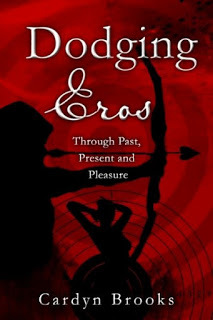
As of October 31, 2018 the Private Moments Publishing imprint of 5 Prince Media is closed. Margins run lean even for the big 5 publishers and those margins are paper thin for indies and small presses.
My thanks to Bernadette Marie for being a supportive publisher who is also a talented author who respects other authors. Working with her and her team strengthened my writing and enriched my life.
Sites that are offering DE for exorbitant prices are not affiliated with me in any way.
Happy Writing & Reading to all!
Cardyn
P.S. I'm still deciding when and how to reissue DE.
Published on November 13, 2018 11:56
November 5, 2018
#NaNoWriMo Readathon Saturday, November 3, 2018
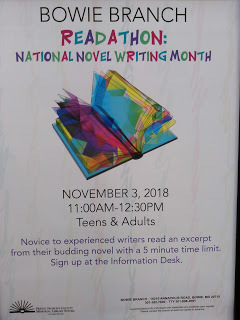
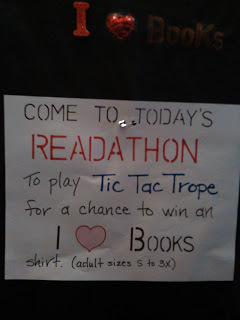
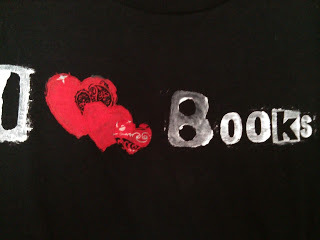
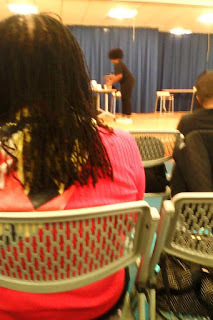
Happy National Novel Writing Month!
This is what you missed at the #NaNoWriMo Readathon at the Bowie Branch Library Saturday, November 3rd:
novelists a poet an essayist a playwright a memoirist dedicated readers games free “I <3 Books” T-shirts All brought together by a phenomenal librarian!
Where are the photos of the event and my display?You ask.
Well, snapping pics never seems to make it onto my mental to-do list until AFTER an event has ended. (A chronic oversight that’s likely Freudian in nature.) Blame my camera averse inner hermit, who also didn’t want to video record my segment. But my parents* (the same people who frequently call me about “fixing” the solid blue screen on their television) did. The blurry photo of me standing in profile leaning forward with my shirt baggy at the waist (SO flattering!) is their contribution as my self-appointed film crew. (It was a very good natural hair day though.)
All of the writers were captivating as they read excerpts of their impressive work and discussed their creative development quandaries. Their work was gritty, poignant, humorous, melancholy, provocative, emotionally layered, and a whole array of engaging elements.
Thank you to the librarian who coordinated the Readathon, all of the talented participants, and the supportive attendees who were such enthusiastic listeners and gracious beta testers as players of Tic Tac Trope. Everyone contributed to making it a fun event.
Until the next event, I <3 Booklovers, Cardyn
*My parents are smart, talented, lovely loving humans for whom tech-savviness is not a high priority.
Published on November 05, 2018 12:29
November 3, 2018
The Persistence of Memoirs and Venn Diagrams of Identity
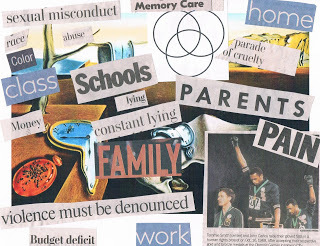
There's some thematic overlap in these lives lived by two very different men on different continents.
The Life and Times of a Very British Man by Kamal Ahmed
https://mediadiversified.org/2018/10/28/the-life-and-times-of-a-very-british-man-by-kamal-ahmed-cardyn-brooks-reviews/
Heavy, An American Memoir by Kiese Laymon Scribner October 16, 2018 non-fiction literature
This intimate mosaic of a complicated, messy life rendered in four parts is as emotionally substantive as it is viscerally grueling. On page 6 when the author asks his grandmother “…whether she minded if we talked about words, memory, emergencies, weight, and sexual violence in our family,” he’s warning readers as well.
Born in Jackson, Mississippi in the mid-1970s to college undergrads in economically impoverished circumstances, Kiese Laymon eventually earned a tenured position at Vassar, an impressive accomplishment made more so by the details of all of the obstacles, setbacks, and dangers he overcame. Plus, getting there signified reaching only one of several peaks in a seemingly endless range of professional and personal mountains to conquer.
Often directly addressing his mother or his grandmother establishes a conversational tone and pace consistent with the sanctity of a secular confessional. Heavy is massive in its emotional scope of revelatory explorations into the weight of words as inflexible, unyielding definitions; as labels, stereotypes, insults, low and negative expectations, sick secrets, past traumas, rigid social class stratification, institutionalized racism, misogyny, and homophobia, post-traumatic stress, addiction, memories. That enormous weight compresses an individual’s personal space and their room to breathe freely. It can narrow their focus and limit the scope of their vision, which probably contributes to the frequency of blanket statements about black folks and white folks, all and every American. Imperfect, fallible, dedicated teachers like the author’s mom and the author strive tirelessly to lighten that load to “give their students permission to be loving and excellent.” [pg. 180]
Examples of linguistic code switching relative to audience, situation and/or the speaker’s motives run throughout K.L.’s development and are presented as a reclaiming of elements of black culture that have been distorted in ways similar to black people who study and collect Negrobilia.
Variations on the phrase, “laughed and laughed until she/he/they didn’t” reinforce the use of humor as a coping strategy as significantly more effective than those suggested by the well-intentioned yet clueless counselor the author and his mom visit once. K.L.’s struggles highlight the long overdue need for resources like the Boris Lawrence Henson Foundation that focus specifically on the mental health needs of black people.
Heavy packs in the consecutive gut punches of Sellout by Paul Beatty with the physical awareness of the body found in Roxane Gay’s Hungerand the connection of violent corporal punishment with distortions in a person’s sexuality as discussed by AnnaLynne McCord (years ago). This beautifully composed memoir echoes the aching longing of multiple generations of unacknowledged, untreated wounds of the body, mind, and spirit.
Published on November 03, 2018 11:18
October 1, 2018
Baltimore Book Festival Saturday, September 29, 2018
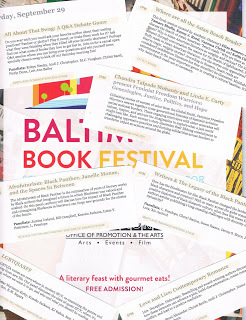
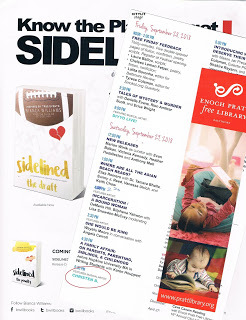
Where Are All the Asian Beach Reads?
Moderator: Aesthetic Distance's Eliza Romero
Panelists: Jay ( - apologies for missing his last name - in for Dr. Tamara Bhalla), Sunny J. Reed, Vanessa Ulrich, Keith Chow
Takeaways:
Middle-brow literature determines current cultural baselines.
Accessibility to inclusive middle-brow lit is essential for the diaspora of readers.
Incompetent diversity in casts of characters sucks a bushel of lemons.
Transracial adoption and racial mirroring are underrepresented in middle-brow lit.
Book rec's:
Prep
The Private Citizens
Free Food for Millionaires
Some of the panelists' media content:
Nerds of Color
Sunny J. Reed blog
Plan A Magazine
Primpy Sheep
Afrofuturism: Black Panther, Janelle Monae, and the Spaces in Between
Moderator: Justina Ireland, author of Dead Nation and editor(?) of Fiyah Magazine
Panelists: Bill Campbell (Rosarium Publishing), Kosoko Jackson, Irette Y. Patterson, L. Penelope
Takeaway:
Reimagining the past to imagine the future sometimes reclaims a more accurate accounting of history, especially when discovering people and their contributions that have been erased from the official record.
Book rec's:
Zone One
Christian Storm Punches a Hole in the Sky
On the Comeup
works by Stephen Barnes
and by Eden Royce
Writers & the Legacy of Black Panther
Moderator: L. Penelope https://lpenelope.com/about-me/
Panelists: Cheryl Barton, Dawn Ibanez, Denny S. Bryce, J.L. Lora, Xio Axelrod
Takeaways:
T'Challa embodies a black man in complete hero mode in conflict with Killmonger as a nuanced villian whose arguments have a some merit.
There's a range of fully developed female characters who are feminine and powerful without mimicking toxic masculinity.
Diversity is not a trend!
Authors' inspirations:
L.A. Banks
Brenda Jackson
Anne Rice
Octavia Butler
Robin Covington
Sandra Brown
Sherrilyn Kenyon
Gloria Naylor
Love and Lies: Contemporary Romance
Panelists: Stoni Alexander, Christi Barth, Andi J. Christopher, Nancy C. Weeks, Kate Clayborn
Things that made people say, "Hmmm."
Why does the fake relationship trope endure?
forced to spend time together permission to flirt extra access to who the other person is team work The secret baby debate got heated between its fans and its haters with valid reasoning on both sides. The panelists agreed that the secondary characters were essential as mirrors for the primary characters, and as safe places where deceitful characters are able to tell the truth. Otherwise, the deceitful characters are irredeemable.
LGBTQIASFF Moderator: Marianne Kirby http://mariannekirby.com/ Panelists: Kosoko Jackson, KJ Kabza, Sam J. Miller, Nibedita Sen, K.M. Szpara
Takeaways: Writing for a mainstream audience versus a queer one The expectation for marginalized authors to educate mainstream/majority readers
Queer canon suggestions: Tensorate series by J.Y. Yang Sadie by Courtney Summers Sam J. Miller quote: "As far as I'm concerned Octavia Butler is the queer canon. And everyone else is extra." Dhalgren by Samuel R. Delany K.M. Szpara recommended works by Sam J. Miller works by Cecilia Tan with her own Circlet Press M.K. Jameson works where queerness is an element in the world building without being the focus. That Inevitable Victorian Thing Autonomous
CityLit Stage Honorable mention to Christen B.'s outstanding musical performance. Her voice evokes an emotional range of expression.
Disclaimer: My brain was still in vacation mode after a glorious stay in Kiawah Island, S.C. until Friday 9/28. Add that fact into the background noise of fellow booklovers and a construction truck next to the Maryland Romance Writers Stage and there are probably a few misspellings and other mistakes. Please accept my apologies for any errors.
Published on October 01, 2018 14:28
September 22, 2018
Last Gasp by Howard Levine
https://black-opal-books.myshopify.com/products/last-gasp
Last Gasp by Howard Levine contemporary (ca. 2010) adult thriller Black Opal Books* September 2018
In Last Gasp, what has become the pervasive threat of mass casualty events due to the intentions of terrorists sets the stage for a thriller with a tale of two brothers at its core. Spinning out from the hub of Vietnam War veteran Frank Tedeschi’s personal and professional relationships, each connection moves the investigation into the conspiracy theory forward, while incorporating momentum from past events. The blending of the present-day events in 2010 with Frank’s experiences in the 1970s highlights the similarities between two generations of debate about patriotism. Zealotry of all kinds is portrayed and challenged, as in this passage on page 24:
Both factions justified their positions with quotes from the Koran, which was seemingly every bit as malleable as the Bible.
Last Gasp combines social commentary on the ongoing debates about printable guns, xenophobia, questionable detainments without due process, blind faith versus lapsed faith, disillusionment, and the consequences of war. In particular, Frank’s relationships with his wife, his brother, and with his military buddy connect the overarching themes to the personal intimacies of everyday life. There are scenes reminiscent of Ray Donovan, and also a surprising amount of humor in this entertaining read that explores the complexity of manhood.
*The author and I are indirectly affiliated through our both being published by Black Opal Books.
Last Gasp by Howard Levine contemporary (ca. 2010) adult thriller Black Opal Books* September 2018
In Last Gasp, what has become the pervasive threat of mass casualty events due to the intentions of terrorists sets the stage for a thriller with a tale of two brothers at its core. Spinning out from the hub of Vietnam War veteran Frank Tedeschi’s personal and professional relationships, each connection moves the investigation into the conspiracy theory forward, while incorporating momentum from past events. The blending of the present-day events in 2010 with Frank’s experiences in the 1970s highlights the similarities between two generations of debate about patriotism. Zealotry of all kinds is portrayed and challenged, as in this passage on page 24:
Both factions justified their positions with quotes from the Koran, which was seemingly every bit as malleable as the Bible.
Last Gasp combines social commentary on the ongoing debates about printable guns, xenophobia, questionable detainments without due process, blind faith versus lapsed faith, disillusionment, and the consequences of war. In particular, Frank’s relationships with his wife, his brother, and with his military buddy connect the overarching themes to the personal intimacies of everyday life. There are scenes reminiscent of Ray Donovan, and also a surprising amount of humor in this entertaining read that explores the complexity of manhood.
*The author and I are indirectly affiliated through our both being published by Black Opal Books.
Published on September 22, 2018 13:17
September 21, 2018
A Modern Memoir, Ancient Mythology, the Cosmos and a Whodunit
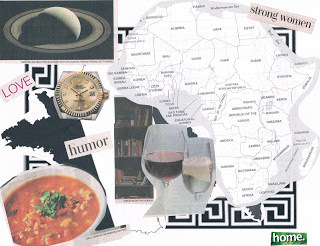
Always Another Country, A Memoir of Exile and Homeby Sisonke Msimang World Editions 4 September 2018non-fiction feminist literature
An individual’s memoir always includes other people, families, and communities. Context matters. In Always Another Country, generations of the author’s family embark upon a nomadic sojourn from South Africa to Russia, Tanzania, Zambia, Kenya, Canada, and Ethiopia, then back to Zambia in an overlapping circuitous route across continents and decades that ultimately returns them to South Africa with excursions into the United States soon after the election of Nelson Mandela as president of S.A. The integrity of their family connections between each other and their nation or origin gets challenged and changed by their experiences in each temporary homestead.
While “Families are nothing without the stories they tell,” is proclaimed on page 111, this idea of personal history as collaborative narration is visually established with a personal photo at the beginning of each chapter. Small square images with fuzzy edges (probably with the date they were developed rubber-stamped on the back) evolve into larger rectangular pics with sharper images reflective of the passage of time for the subjects, their settings, and the technology used to capture them. There is a familiar universality to the composition of each image that mirrors collections in family photo albums around the world, and the universal themes of sexism, xenophobia, elitism, racism, government bureaucracy, shifting political alliances, and tyranny running beneath the superficial differences of skin color, geographical location, culture, and language eventually reveal themselves in every destination.
Different countries with essentially identical rules of engagement according to an entrenched human hierarchy are acknowledged throughout Always Another Country, most succinctly in the following three passages:
I was in another country, but somehow things were the same. [pg. 62]
Their children in Nairobi whose particular corners of misery might as well have been another country. [pg. 64]
We followed her every command because the immigrant child knows that outside is one thing but home is another country. [pg. 83]
With a delicate touch, Sisonke Msimang’s lyrical prose conveys a stalwart pragmatism to her revelatory confessions of obliviousness, arrogance, and naïveté sourced from her life of privilege. The exploration of her claimed and competing identities versus what’s projected onto her by others based on gender, age, and skin color supports the recurring variations on riffs about developing a thick skin, sloughing off dead skin, and skin as a beacon that can simultaneously draw unwanted attention and indicate shared membership in a group. Emotionally, Always Another Country shares a textural affinity with Ellis Cose’s The Rage of a Privileged Class.
Entrenched and contradictory expectations about women’s sexual virtue, men’s entitlement, and sexual predation run throughout this compelling personal narrative that deconstructs the luxuries of innocence, youth, exile, and hindsight when the privileged people are female, black, brown, refugees or in any way labeled as outsiders by those who wield significant power and authority over others.
Sisonke Msimang’s distinctive voice spans a range of octaves to compose this dramatic opera about the international and internal and perpetual battle between the haves and the have-nots. My preceding remarks only hint at the depth and complexity with which Always Another Country offers in its micro to macro study of the human condition.
Mortals and Immortals of Greek Mythology by Francoise Rachmuhl and Charlotte Gastaut Lion Forge 18 September 2018 children’s literature
Mortals and Immortals of Greek Mythology works as an updated, abridged version of Edith Hamilton’s Mythologymodified for middle schoolers.* Incest and infidelities, murder and mayhem are glossed over or described in sanitized terms. For example, Zeus’s extramarital affairs and sexual assaults are labeled as “adventures” in the summary of his personal life. Hmm. Greek mythology is inherently not kid-friendly content, which makes the designation of this book as being for children ages 9 to 12 years old or in the 4th through 6th grades seem problematic. “Greek tragedy” is a common phrase for legitimate reasons. Parents and guardians will enjoy reading the text and savoring the evocative artwork as they evaluate its appropriateness for their children.
Each section features a headliner with information about secondary personalities and conflicts interwoven into the details of their origin stories. Characters and key elements are rendered in layered images with mortal and immortal figures in white silhouette. Most facial features are elongated to a humanoid appearance. Graduated color saturation in a mix of pastels and primary colors from translucent to opaque form backgrounds that highlight sharp edges and soft curves. Some sepia-toned ink drawings and woodcuts fall among a variety of artistic techniques in these gorgeous illustrations.
One element that captured my attention at first glance of the two figures on the cover is their stark whiteness. Now if this were a collection of condensed bios about characters in Norse mythology the white-default wouldn’t seem incongruous. Greece is located in the Mediterranean. Greek people aren’t typically pale. Ancient Greeks were probably very brown during the generations before the invention of sunscreen. A browse of the projects link on Charlotte Gastaut’s website shows that this stark white silhouette is a signature element of her work and her other projects include a smattering of brown faces. In Mortals and Immortals of Greek MythologyPoseidon is shown in shades of blue. Plus, a few brown figures may be included among the pages that would not load for me in the e-ARC.
It just seems as if in the years since #WeNeedDiverseBooks and #1000blackgirlbooks generated robust public discussion and inspired action to expand casts of characters and inclusive representation of all kinds of people in children’s books, that the white-default element of these exquisite illustrations feels outdated.
*My e-ARC wouldn’t load the last third of the content, making this review based on the first two-thirds of the work.
Dispatches from Planet 3 by Marcia Bartusiak Yale University Press 18 September 2018 non-fiction science
From collegial collaborations to unacknowledged attributions and vindications delayed, Dispatches from Planet 3uses a joyously inquisitive approach to science to tell the saga of the continuous human journey to greater enlightenment about the mechanics of existence. As a layperson’s survey of astronomy, cosmology, and physics it charts trends in attitudes toward hard sciences as embodied in the naïveté of the hysteria generated by Orson Wells’s War of the Worlds broadcast to the insatiable imaginative possibilities of Gene Roddenberry’s various “Star Trek” series and the pragmatism of Octavia Butler’s Kindred in terms of connections between time and space.
The author encourages readers to select the order of reading these thirty-two essays according to their personal preference, but reading them as numbered offers the benefit of providing an evolutionary momentum of scientific inquiries from Epicurus in the 4th century BCE to the present day. Familiar names like Aristotle, Galileo, Newton, Einstein, and Hubble are placed in context with the significant contributions of lesser-known scientists Jocelyn Bell Burnell, Beatrice Tinsley, Cecilia Helena Payne, Henrietta Swan Leavitt, Vera Rubin, Karl Jansky, Vesto Slipher, Chandra (one name says it all like Einstein and Beyoncé), Lisa Randall, and a Midwestern farm boy and a Belgian priest. (No, the last two aren’t the intro to a joke about who walks into a bar—or an observatory.)
The human path to scientific understanding has been grueling, circuitous, and often redundant or ahead of its time and available tools. “There’s no news like old news,” from page 163 is repeatedly validated in the author’s reporting about discarded theories that were verified as fact decades later. Science fiction is constantly being revised and rewritten. So are science facts.
On page 5 Bartusiak writes, “Indeed, our cosmic address is getting excruciatingly long: Planet No. 3, Solar System, Orion Spur on Sagittarius Spiral Arm, Milky Way, Local Cluster, Virgo Supercluster, Universe, Multiverse.” Each location marker zooms farther out from Earth, making it more apparent with every discovery that humans are not the center of existence.
These thirty-two essays include photos, charts, illustrations, diagrams, and an image of correspondence from the 1700s. They are divided into three categories: Celestial Neighborhood, Realm of the Galaxies, and To the Big Bang and Beyond, reflective of the author’s notable affinity for pop culture references. There are notes, a bibliography, acknowledgments, and an index.
NASA human “computer” Katherine Johnson recently celebrated her 100thbirthday after having a building named for her, and witnessing the unveiling of her statue at West Virginia State University. Dispatches from Planet 3 honors scientific trailblazers of the past from around the world, examines current exploration challenges, and inspires deeper study. “Star Talk” with Neil DeGrasse Tyson is video content as bait to lure the general public into personal engagement with science. This collection of essays is “Star Writing” that does the same.
Death in Paris by Emilia Bernhard Thistle Publishing 9 October 2018 adult contemporary mystery fiction
Resurrect Lucille Ball and Vivian Vance as Lucy Ricardo and Ethel Mertz, transplant them to 21st-century Paris, France, and let the high jinx ensue. Rachel and Magda’s twenty-year friendship anchors this amusing mystery romp filled with sardonic literary references and nods to pop culture and assorted vintage fictional investigators. Women of all ages and types are featured in a setting sprinkled with elements of French Women Don’t Get Fat and the Scooby Doo cartoon.
This passage on page 11 articulates the themes of hindsight and generational increments of change that run throughout this charming farce:
For a moment the two women reflected on the Paris of twenty years before, gymless and untouched by fat-free food.
A deep affection for a Paris with at least as many facets as arrondissements permeates the breezy narrative. Red herrings and blind alleys work with other familiar tropes and trends in commercial mystery fiction to offer readers a cozy whodunit as meta commentary about the uncertainty of modern life and the differences between crime-solving in entertainment content and in real life. Rachel and Magda debate their investigative approach on page 43:
“But I also think we can’t carry on the way we just were, all feelings and maybes, as if it were a cozy mystery novel. We need to treat this like a police inquiry.”
Ultimately, Death in Paris is a tale that focuses on the consequences of personal relationships that are appreciated, nurtured, squandered or exploited. If this is the first in a series, the author has established a solid foundation for the further adventures of Rachel, Magda, and their circle of family, friends, and associates.
There’s a glossary of French words at the end, followed by the acknowledgments, which, in order to avoid significant spoilers, should not be read prior to finishing Death in Paris.
Published on September 21, 2018 08:13
September 6, 2018
There's No Place Like Home
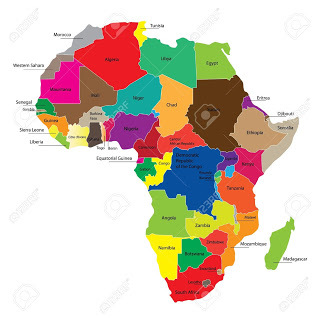 image from 123RF.com
image from 123RF.com Always Another Country by Sisonke Msimang
https://mediadiversified.org/2018/09/02/always-another-country-by-sisonke-msimang-cardyn-brooks-reviews/
Published on September 06, 2018 15:53



